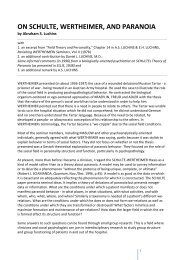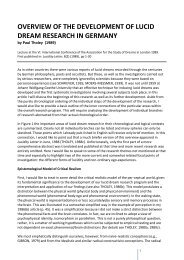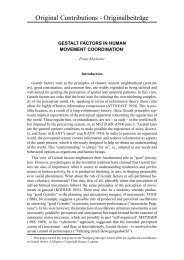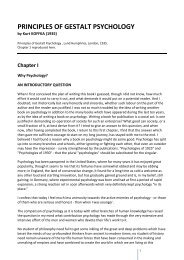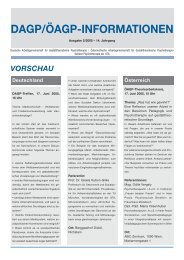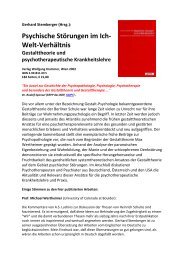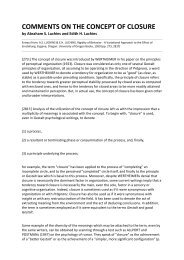Mary HENLE - Society for Gestalt Theory and its Applications (GTA)
Mary HENLE - Society for Gestalt Theory and its Applications (GTA)
Mary HENLE - Society for Gestalt Theory and its Applications (GTA)
- No tags were found...
Create successful ePaper yourself
Turn your PDF publications into a flip-book with our unique Google optimized e-Paper software.
'To change a habit involves pulling that habit out of the background again <strong>and</strong> investing energy . . .to disintegrate or to reorganize the habit' (1969/1972:66). This time Perls apparently means -focus attention on the activity usually per<strong>for</strong>med automatically. I have no doubt that it is possibleto conceptualize an activity sequence in <strong>Gestalt</strong> terms, but Perls has not done it - he has merelyused the words. lf his expression is equivalent to Rubin's distinction, this remains to be shown.Perls asserts that ritual 'makes the gestalt clearer, makes, the figure st<strong>and</strong> out more sharply'(1973:29). The meaning is apparently once more that the special importance of something is beingemphasized. I need not repeat my remarks about importance. But what is the figure that is madeto st<strong>and</strong> out by a h<strong>and</strong>shake or a toast? Perhaps the h<strong>and</strong>shake emphasizes the beginning or theend of an encounter, but what is the structure of the encounter? The use of figure-groundterminology is no substitute <strong>for</strong> specifying the characteristics of a social event.At one point Perls tells us that he is bogged down in his writing <strong>and</strong> remarks, 'I would not be a<strong>Gestalt</strong>ist if I could not enter the experience of being bogged down with confidence that somefigure will emerge from the chaotic background' (1969/1972:37-38). What he means, it wouldseem, is that he is sure he will find something to say. Again, what is gained by speaking of figure?What is lost, I repeat, is the specific meaning of figure <strong>and</strong> ground. Incidentally, a chaoticbackground is hardly conducive to the segregation of a figure.Perls finds it important that figure <strong>and</strong> background be easily interchangeable. 'Otherwise we get adisturbance in the attention system-confusion, loss of being in touch, inability to concentrate <strong>and</strong>to get involved' (1969/1972:93). lt has been pointed out earlier that in perception reversiblefigures are the exception. From the context it appears the Perls means that, <strong>for</strong> optimalfunctioning, there must be an alternation between what he calls coping <strong>and</strong> withdrawal, theremust be flexibility of the personality, <strong>and</strong> the like; but what these have in common with figure <strong>and</strong>ground in the sense of Rubin <strong>and</strong> the <strong>Gestalt</strong> psychologists is never made clear.In all these examples, <strong>and</strong> many others that might be discussed, it seems to me that the figuregroundterminology is used so loosely by Perls that it conceals problems rather than clarifies them.Since <strong>Gestalt</strong> psychologists emphasize organization, let us turn to that problem. As Köhler puts it,organization 'refers to the fact that sensory fields have in a way their own social psychology'(1947:120). That is, certain un<strong>its</strong> or groups exist which are relatively segregated from theirenvironment: certain parts of, say, the visual field belong together <strong>and</strong> are segregated fromothers. Wertheimer investigated the factors that govern perceptual organization: similarity,proximity, good continuation, closure, etc.Of Wertheimers factors of orginization, the only one in which Perls shows any interest is closure<strong>and</strong> lack of closure. The latter term he uses interchangeably with 'unfinished situation' - atechnique, not a concept, derived from Lewin. Let us consider some examples of unclosed gestaltsas they are used in gestalt therapy.'Our life is basically practically nothing but an infinite number of unfinished situations-incompletegestalts.' writes Perls. 'No sooner have we finished one situation than another comes up'(1969/1971:15). The neurotic 'indivual somehow interrupts the ongoing processes of life <strong>and</strong>saddles himself with so many unfinished situations that he cannot satisfactorily get on with theprocess of living' (1973:23). These unfinished situations from the past compel him to repeat themin everyday life (1973:91). (Incidentally, Freud's repetition compulsion is here made a matter of5



